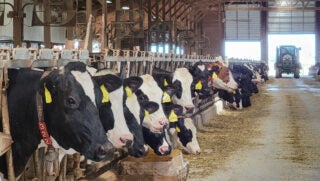With origins dating back roughly 2,000 years to Europe, Holstein cows are celebrated for their impressive milk production.
The noble Holstein is the cow for here and now when it comes to milk production. And actually, its dairy dominance goes back hundreds of years, if not thousands. With some 22 million animals registered, the Holstein accounts for about 20 percent of all U.S. dairy cattle, and some would argue it makes for a decent burger as well. Known for its white coat and black spots, pictures of Holsteins often grace the covers of any magazine devoted to not just dairy, but to cattle in general.
Whether you’re a dairy operator, or a beef producer looking to add some new genetics to the herd, or perhaps just interested in the black-and-white cows that dot the American landscape from coast to coast, below are five quick Holstein facts which you’d butter know before trying to talk cattle with a cow-man.
1. Thanks much to the Dutch
The modern Holstein traces its ancestry to the Netherlands to close to the Year 0 (the divide between B.C. and A.D.). Almost 2,000 years ago, the migrant tribes of Europe flowing in and around that area began crossing the black cattle of the Batavians with the white cows of Friesians for the purposes of increasing milk production on restrictive grounds. Those crossings produced the Dutch animal known as the Holstein-Friesian. As colonists began to settle the North American continent in the 17th through 19th centuries, they looked to the dairy breeders of Holland for answers. In 1852, Winthrop Chenery, a Massachusetts breeder, purchased a Holland cow from a Dutch sea captain who had used her to provide milk for his crew. Chenery was so happy with the milk production he imported more Holsteins in 1857, 1859, and 1861, inspiring other American farmers to do the same. Some 8,000 Holsteins were imported from Europe before a cattle disease broke out on that continent and importations ceased.
2. Prolific numbers
More than 22 million animals are registered in the Holstein Association’s database, with the ancestry almost exclusively going back to the original cattle brought over the Netherlands. Comprising nearly 20 percent of all U.S. dairy cattle, Holstein genetics are sought worldwide by milk producers in nearly every country. Meanwhile, the Holstein Association USA is the largest dairy breed group in the world, headquartered in Brattleboro, Vermont, since 1903. With more than 20,000 adult members, and 8,000 youth, the association processes more than 370,000 registrations, and 70,000 transfers each year, with a daily average of 1,400.
3. Good-sized cattle
Born as 90-pound calves, the mature Holstein cow grows to about 1,500 pounds and stands 58 inches at the shoulder. Heifers are typically bred after 13 months and 800 pounds, so as to calve between 23 and 26 months. Typical gestation is nine months, with the average productivity lasting about four years. Meanwhile, the 2017 average actual production for all U.S. Holstein herds that were enrolled in production-testing programs was 25,676 pounds of milk, 963 pounds of buttermilk, and 799 pounds of protein annually. Top producers have been known to produce more than 72,000 pounds of milk per 365-day year.
4. Where’s the beef?
Even though the breed is best known for dairy production, many a Holstein bull calf has been raised for hamburger and leather. And according to most studies, the beef is actually quite good. Research at Cornell University suggests that Holstein steers can produce a beef equal to, or in some cases, superior to, traditional breeds such as Hereford and Black Angus. The question for researchers has typically been one of feeding strategies for steers typically raised at a dairy. While most of the data does suggest a higher grain diet for Holstein beef, the recent consumer demand for grass-fed, added-hormone-free beef, has researchers checking into those options as well. The upside to Holstein beef is that the same genetics that makes its mothers and sisters milk well does tend to increase the marbling. The downside is that if graining these steers, remember that as dairy-born, they have higher nutritional requirements. Typical beef cattle require a 56 to 58 mega-calorie diet while Holsteins typically need between 60 and 62.
5. One for the record books
And so it’s no surprise that it was a Holstein cow in Wisconsin that set the single-lactation national milk production record of 77,480 pounds, or 9,009 gallons, in 365 days. Named Ever-Green-View My Gold-ET, she reportedly calved at four years and three months. A cow whose pedigree includes numerous strong milkers, her record displaced yes, another Holstein, Bur-Wall Buckeye Gigi, also from Wisconsin, which had generated 74,650 pounds of milk in 365 days.
Curious about other breeds? Here are 7 facts about Black Angus cattle, 7 facts about Hereford cattle, 6 facts about Japanese Wagyu cattle, as well as a list of the most popular cattle breeds in the U.S.
Brian Boyce is an award-winning writer living on a farm in west-central Indiana. You can see more of his work at www.boycegroupinc.com.



